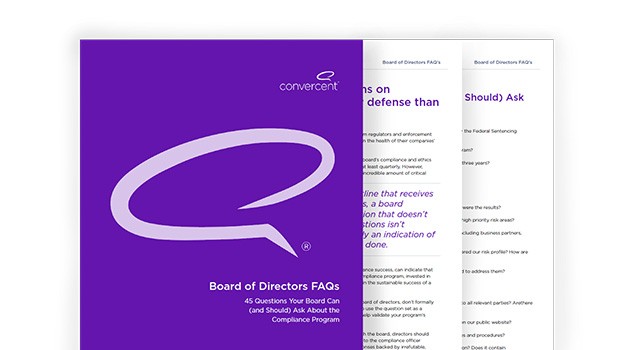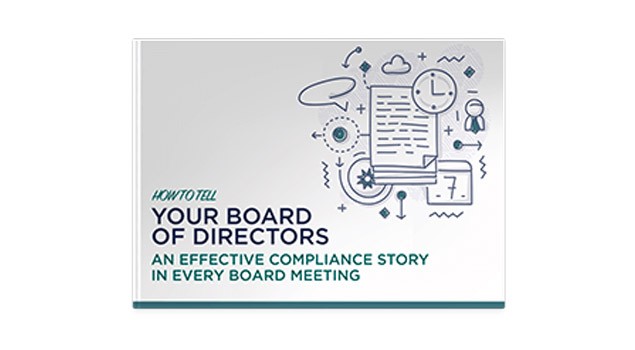Some executives we talk to find giving a compliance presentation to the board of directors a nerve-racking experience, while others seem to take it in stride. Whether you like your time on center stage or prefer it be over with as fast as possible, these 10 guidelines will help you to present data in a way that does more than just satisfy board members’ fiduciary responsibility about risk mitigation. They will allow you to illustrate how compliance can be a vital part of a vibrant, forward-looking growth strategy.
Best Practices When Giving a Compliance Presentation to the Board of Directors
1. DO organize your data and put it in context
During your board of directors presentation, let them know you’re on top of the data, and using it to drive forward-looking policies that help the company become better at what it does. Your primary aim should be to tell a compelling story that’s reinforced with data—not to present every metric that you’ve measured over the last quarter. Pare down the information into clear and concise summaries, such as how many hotline calls you’ve had, how many have been resolved, or where and why you’ve launched new policies. Be sure to highlight trends, hot spots, or areas of significant change—and include context that can help demonstrate the “why” behind the numbers.
2. DO have a message
While it is important to deliver a key set of metrics in each report, it’s also important to paint a picture for the board with your data. This demonstrates you understand how to steer compliance, not just manage it.
Questions to ask yourself: What is it you’re trying to say? Do you need to report on bad news, and what’s being done about it? Are you reporting on little news, which should be a cause for demonstrating your effectiveness?
No matter what you’re reporting, find the story that’s in the data. Perhaps you’re making a point for more compliance investment – where does the data support that the investment would have a strong return?
3. DO use clear and simple visuals
You may love spreadsheets and PowerPoints, but they can be boring ways to present information if not carefully considered. If you present slides with too much too much text and too many numbers, charts, and tables, the board will tune out and merely passively receive your information. You want them to be actively consuming it, so that they are inspired by what you’re saying.
If you have an administrative assistant prepare your materials, be sure to give the presentation an executive touch – streamline and cut anything that’s not necessary for the board. You can explain what they’re seeing, so that you don’t have to put everything into your visuals.
4. DO be brief
Compliance is your field, not theirs. While you can prepare a longer talk, save some details for the Q&A, when you can dive deeper into the topics that interest your board to demonstrate your depth of knowledge. (Want to anticipate some of the questions they may have? Download our guide to the most frequently asked questions during compliance presentations to the board of directors).
5. DO report the warts
Don’t omit or downplay problem areas. To exercise effective oversight, the board should be aware of all significant risks, incidents, and missteps. These happen in every company, no matter how effective compliance is—and your board knows that. They will get suspicious if their executive in charge of risk tells them that there is no risk.
After sharing the bad news, provide a solution that has a corrective action plan, and engage the board in dialogue about their thoughts. Since some board members reside on multiple boards, they may have already seen something similar and have good suggestions or feedback for your corrective initiative.
5 Don’ts When Giving a Compliance Presentation to the Board of Directors
1. DON’T live in a vacuum
Provide a frame of reference for the board by leveraging benchmarking data, including industry averages, current best practices, and your own company’s past successes. Benchmarking is one of the easiest and clearest ways to show that you’re on top of your job, and put your results in context.
If you don’t currently benchmark, it’s a good time to make the case for why you should: Make it clear that regulators and enforcement agencies will compare your company to others in the industry if you do come under investigation. Communicate that benchmarking should be a standard practice, and will provide valuable fodder for future discussion on program results, progress, and resourcing.
2. DON’T pretend to know it all
It’s okay to say, “I don’t know.”
Admitting that you’re not sure of an answer to a question—even during a moment as important as your quarterly compliance presentation to the board—is preferable to taking a wild guess or meandering around your mind for a vague answer. If someone asks you a good question you don’t know the answer to, let them know it’s an excellent question, that you’ll find the answer to it, and that you’ll report back to them about it. Then do exactly that.
You can’t and shouldn’t know the answers to all the questions you might be asked. Being prepared for what you don’t know is part of being well prepared.
3. DON’T wing it
Speech trainers always have their clients practice speaking. If you prepare mentally, but haven’t actually talked through your presentation, you could be setting yourself up for disaster.
Plan your talk, and then give the talk to your empty office. Or your spouse. Or dog. Time it. You can even record it if you’d like, to see how you sound and appear. This can be almost as nerve-wracking as an actual presentation, but the preparation and the self-knowledge will go a long way to helping you appear capable and confident.
4. DON’T confuse professional with boring
It should go without saying that a compliance presentation to the board–even one you know well–should be done professionally. Appropriate dress, careful language, and engaging conversations that avoid getting too personal are all expected.
But that doesn’t mean you can’t bring a sense of humor or a little personal flair into your board of directors presentation. The board doesn’t want a stiff, too-polished report. Be prepared enough to present your data and conclusions in a conversational way that is friendly and accessible, not stiff and corporate.
You’re not presenting to a judge, but to colleagues—so finding that sweet spot between professional and conversational can make the data you’re presenting more memorable and bring your presentation to life.
5. DON’T cut time from Q&A
Your board will—and should—have questions, so leave them time to ask them. It’s an opportunity to demonstrate your acumen and effectiveness while engaging in a more interactive forum.
Check out our list of 45 frequently asked questions during compliance presentations to the board. Prepare responses to those questions, and be able to drill down into any irregularities, trends, or key incidents to communicate what’s happening.
Make sure you’re up to speed on current events–up to the day of your presentation. Consider if any of them might impact your company and, if so, what you’re considering to stay out ahead of the issue, and out of the headlines.
45 FAQs during compliance presentations to the Board of Directors
Be as prepared as possible and anticipate the questions you’re likely to receive using our free eBook, 45 Questions Your Board Will Ask About Your Compliance Program.


